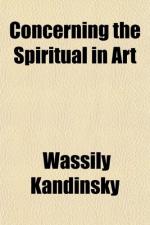So the abstract idea is creeping into art, although, only yesterday, it was scorned and obscured by purely material ideals. Its gradual advance is natural enough, for in proportion as the organic form falls into the background, the abstract ideal achieves greater prominence.
But the organic form possesses all the same an inner harmony of its own, which may be either the same as that of its abstract parallel (thus producing a simple combination of the two elements) or totally different (in which case the combination may be unavoidably discordant). However diminished in importance the organic form may be, its inner note will always be heard; and for this reason the choice of material objects is an important one. The spiritual accord of the organic with the abstract element may strengthen the appeal of the latter (as much by contrast as by similarity) or may destroy it.
Suppose a rhomboidal composition, made up of a number of human figures. The artist asks himself: Are these human figures an absolute necessity to the composition, or should they be replaced by other forms, and that without affecting the fundamental harmony of the whole? If the answer is “Yes,” we have a case in which the material appeal directly weakens the abstract appeal. The human form must either be replaced by another object which, whether by similarity or contrast, will strengthen the abstract appeal, or must remain a purely non-material symbol. [Footnote: Cf. Translator’s Introduction, pp. xviii and xx.—M.T.H.S.]
Once more the metaphor of the piano. For “colour” or “form” substitute “object.” Every object has its own life and therefore its own appeal; man is continually subject to these appeals. But the results are often dubbed either sub—or super-conscious. Nature, that is to say the ever-changing surroundings of man, sets in vibration the strings of the piano (the soul) by manipulation of the keys (the various objects with their several appeals).
The impressions we receive, which often appear merely chaotic, consist of three elements: the impression of the colour of the object, of its form, and of its combined colour and form, i.e. of the object itself.




